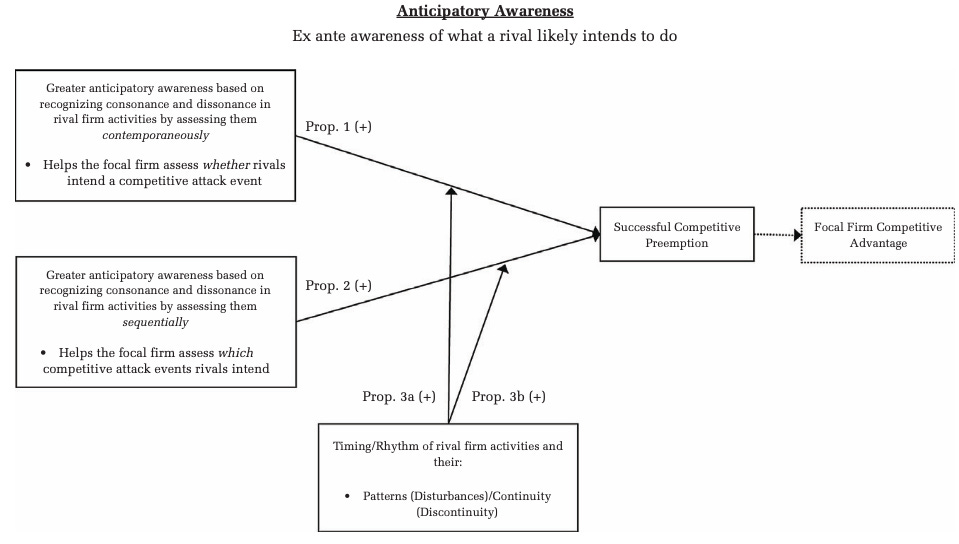How Music Theory Can Inform Competitive Dynamics
What chords and rhythms tell us about anticipating other’s actions
The Nutshell: Listeners to music can form a good expectation of what’s coming next in the near term. A recent Academy of Management Review paper unpicks the processes that enable this, and suggests they may be used by company managers to anticipate and pre-empt rivals’ moves and strategies.
Source: https://doi.org/10.5465/amr.2022.0263
The field of design thinking adapted what practicing designers and inventors do, to create a new theory of management innovation. On a smaller scale, so far, but not altogether dissimilarly, a September 2024 Academy of Management Review article looks at what musicians do, to formulate a theory of event anticipation.
In the paper, “How Music Theory Can Inform Competitive Dynamics: Anticipatory Awareness and Successful Preemption,” authors Eric Lee, John Busenbark, Michael Withers and Edward Zajac use insights from music theory to advance a framework by which managers may enhance their anticipatory awareness in competitive environments.
There is a vast literature on competitive advantage, and within this on anticipating competitive behavior and the action of rivals, a sub-field known as “competitive dynamics.”
According to the article, competitive dynamics rests largely on the Awareness-Motivation-Capability (AMC) framework of Tuschke & Salomon (2019), but this awareness considers only a rival’s observed actions as the relevant stimulus.
What Lee et al. offer is visibility prior to the awareness stage, that is anticipation of a rival’s intention to act (thereby enhancing ability to pre-emptively respond).
To achieve this, they mine music theory for a process by which anticipatory awareness manifests itself, and find this in tonal harmony and rhythm where a band member or listener anticipates what is coming next by recognizing consonance and dissonance in musical notes or patterns in timing.
The first element is how listeners assess compound musical notes to develop anticipation. A single note by itself carries no forward freight, but several contemporaneous notes (a chord) alert the listener to consonance and dissonance, where dissonance particularly, implies directedness (back to consonance.)
Next is how musical notes arouse expectation by their arrangement in time, for example how the 7th note leads to the tonic, among many similar familiar, recognised progressions
Both of these occur against a background of rhythm and timing, a prior established pattern of continuity as to when a new development is most likely to occur.
The analogy spelled out is that rival firms’ moves may be recognized as musical notes. As listeners anticipate the future direction of notes as they emerge, so firms may anticipate the competitors’ actions by listening for chords, progressions and patterns in the event space.
Firms rarely structure their competitive moves in isolation. More usually there is a repertoire of reinforcing i.e. chord activities, and a sequence of events, in line with or in contrast with a context of prior patterns of expectation.
The authors say, “firms that can interpret rival firm activities—whether as individual acts or collectively in competitive repertoires from the same time interval—across multiple meaningful time intervals are more accurate in their anticipatory awareness… and thus engage in more successful competitive pre-emption.”
The piece dips briefly into a real-world example:
“In 2016, Tesla engaged in several activities that, if observed in isolation, may have seemed unrelated and unremarkable, thus not pointing toward a future competitive event. First, Tesla CEO Elon Musk introduced the Powerwall, a new product that facilitates the transfer of energy between solar panels and electric vehicles (Carr, 2017). Shortly thereafter, Tesla opened a battery factory to produce longer-lasting batteries…
“Each of these activities may invoke consonance when assessed in isolation, but when assessed contemporaneously as being interrelated since they all occurred within a short time interval, other firms may have deciphered these activities as being dissonant, thus anticipating resolution via an eventual competitive attack event.”
But, this minor nod to real-world application only whets the appetite. It calls for the intriguing, salutary analogy between musical and business near-term anticipation to be fully demonstrated in a business case study.




